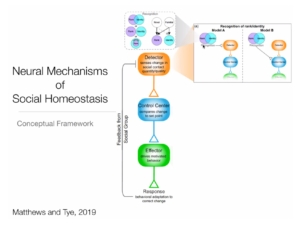Research Brief: Social Homeostasis
- Kay Tye studies homeostatic mechanisms underlying social interactions and deviation from a set point (social isolation/loneliness).
- Dorsal raphe nucleus (DRN) dopamine neurons are the putative “effector” mechanism in “social homeostasis.”
- They become more responsive to social stimuli after isolation, “an unpleasant aversive state.”

- According to Tye, rank is a way to access the subjectivity of social isolation, in that “the degree to which neurons modulate behavior is predicted by social rank” (Matthews et al., 2016; Matthews & Tye, 2019).
- Tye is also looking at how rank changes, depending on context (for humans, at home, in the lab, at the store, etc.).


